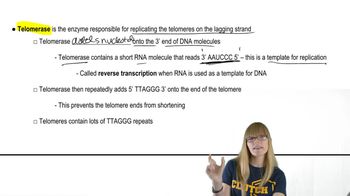Table of contents
- 1. Introduction to Genetics51m
- 2. Mendel's Laws of Inheritance3h 37m
- 3. Extensions to Mendelian Inheritance2h 41m
- 4. Genetic Mapping and Linkage2h 28m
- 5. Genetics of Bacteria and Viruses1h 21m
- 6. Chromosomal Variation1h 48m
- 7. DNA and Chromosome Structure56m
- 8. DNA Replication1h 10m
- 9. Mitosis and Meiosis1h 34m
- 10. Transcription1h 0m
- 11. Translation58m
- 12. Gene Regulation in Prokaryotes1h 19m
- 13. Gene Regulation in Eukaryotes44m
- 14. Genetic Control of Development44m
- 15. Genomes and Genomics1h 50m
- 16. Transposable Elements47m
- 17. Mutation, Repair, and Recombination1h 6m
- 18. Molecular Genetic Tools19m
- 19. Cancer Genetics29m
- 20. Quantitative Genetics1h 26m
- 21. Population Genetics50m
- 22. Evolutionary Genetics29m
8. DNA Replication
Telomeres and Telomerase
Problem 26a
Textbook Question
Telomeres are found at the ends of eukaryotic chromosomes. Why is telomerase usually active in germ-line cells but not in somatic cells?
 Verified step by step guidance
Verified step by step guidance1
Telomeres are repetitive nucleotide sequences at the ends of eukaryotic chromosomes that protect them from deterioration or fusion with neighboring chromosomes.
Each time a cell divides, its telomeres become shorter, which eventually leads to cell aging and death.
Telomerase is an enzyme that adds nucleotide sequences to the ends of telomeres, effectively maintaining their length and allowing cells to divide without losing important DNA sequences.
Germ-line cells, which give rise to gametes (sperm and eggs), need to maintain their telomere length to ensure genetic stability and integrity across generations. Therefore, telomerase is active in these cells.
In contrast, somatic cells (non-reproductive cells) do not typically express telomerase, leading to gradual telomere shortening and contributing to the aging process and limiting the number of times a cell can divide.
 Verified video answer for a similar problem:
Verified video answer for a similar problem:This video solution was recommended by our tutors as helpful for the problem above
Video duration:
3mPlay a video:
Was this helpful?
Key Concepts
Here are the essential concepts you must grasp in order to answer the question correctly.
Telomeres
Telomeres are repetitive nucleotide sequences located at the ends of eukaryotic chromosomes. They protect the chromosome from deterioration and prevent fusion with neighboring chromosomes. Each time a cell divides, telomeres shorten, which is associated with aging and cellular senescence.
Recommended video:
Guided course

Telomeres and Telomerase
Telomerase
Telomerase is an enzyme that adds nucleotide sequences to the ends of telomeres, effectively extending their length. This enzyme is typically active in germ-line cells, allowing them to maintain telomere length across generations, which is crucial for reproductive success and genetic stability.
Recommended video:
Guided course

Telomeres and Telomerase
Germ-line vs. Somatic Cells
Germ-line cells are involved in reproduction and give rise to gametes, while somatic cells make up the body's tissues and organs. The activity of telomerase in germ-line cells ensures that the genetic information is preserved for future generations, whereas its limited activity in somatic cells contributes to the aging process and limits the number of times these cells can divide.
Recommended video:
Guided course

Point Mutations

 8:38m
8:38mWatch next
Master Telomeres and Telomerase with a bite sized video explanation from Kylia Goodner
Start learningRelated Videos
Related Practice

